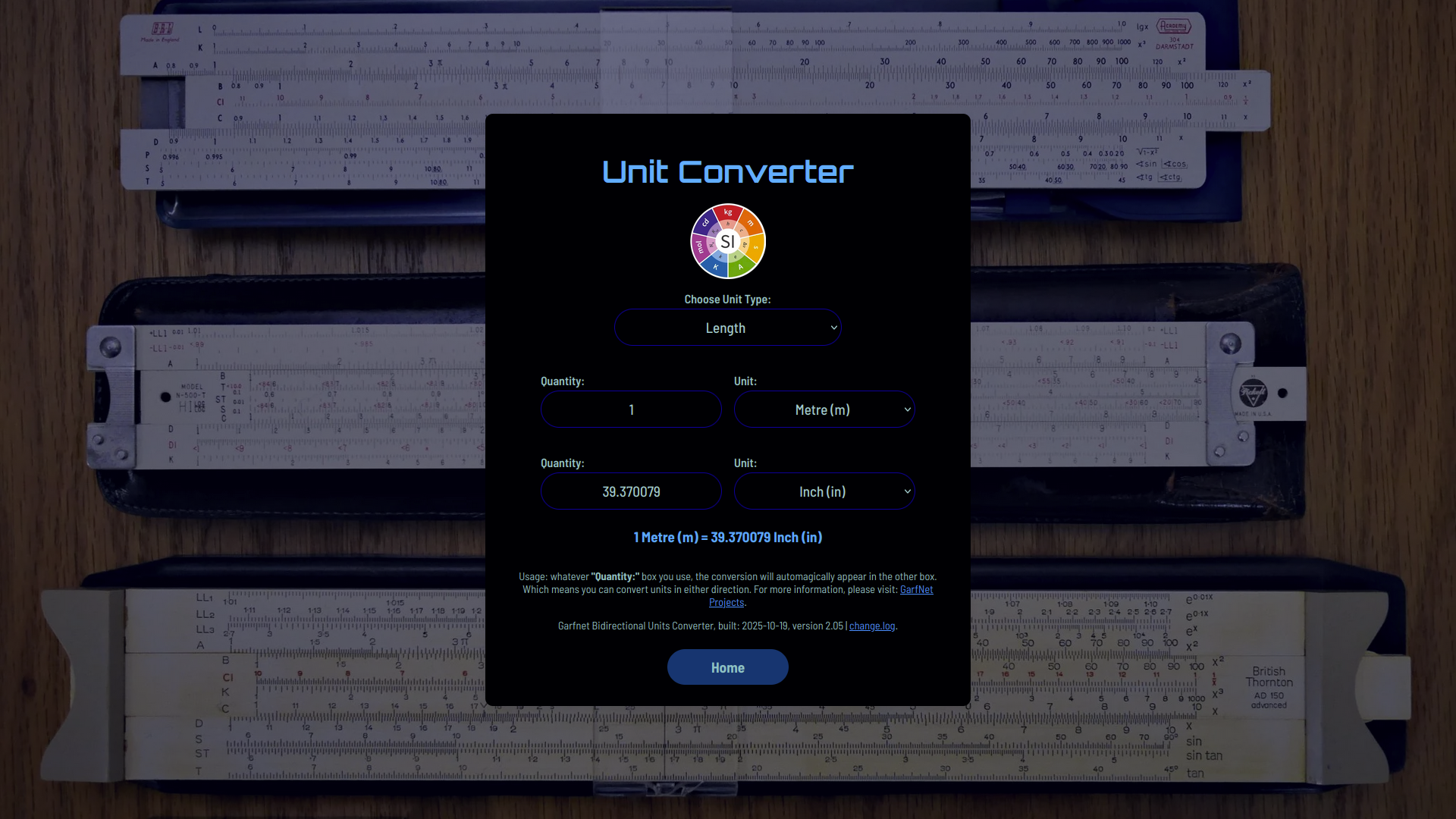GarfNet Unit Converter applet
Skip preamble and launch Units Converter applet
Another GarfNet software project snatched from the grave, this is a complete rebuild of the original GarfNet Unit Converter. The main feature of the new GarfNet converter applet is that it is bi directional. Whatever “Quantity:” box you use, the conversion will automagically appear in the other box. Which means you can convert units in either direction! Another feature is that instead of having a row per conversion type, this offers the user a conversion type pick-list entitled “Choose Unit Type:“. User then selects the type of conversion he/she wants. This populates a pair of “Unit:” pick-lists will all the available conversions for that particular type of unit.
Despite its greatly simplified user interface, this version has a lot more conversions too. It also offers new “Force” section, together with a greatly improved computing section that includes bits and bytes, as well as ISO and IEC multipliers. Its new extensible codebase makes it much easier for the developer to add additional conversions. Importantly it now plays nicely on mobile devices. It also plays nicely with DarkReader theme changer plugin for web browsers. So if you like dark themes then this applet supports them.
Based on SI

To make this applet bi directional required the use of “base units”. We chose to use those provided by the SI metric system. Many commonly used customary units such as the inch, the foot, the yard and the mile are now defined by the metre anyway. So this seemed the obvious way to proceed with this project.
Scientific Notation
By default, Converter will show normal numbers as regular numbers. However when numbers grow too big, or too small, it automatically displays numbers greater than or equal to 100,000,000 as “1e8” and numbers smaller than .0001 in the format “1e-4”, in JavaScript style scientific notation. A number expressed in Scientific notation has two parts:-
- significand
- exponent
The exponent is always the number of times the significand pattern needs to be multiplied by 10 to obtain a value equal to the “regular number”.
For example, the regular number 4321 in scientific notation is represented as
4.321 × 103
In this instance the significand is 4.321 and the exponent is 103
Because this is essentially a JavaScript applet, it displays scientific numbers JavaScript style, in a manner similar to this
4321e3
Where “e” represents a decimal exponent, and the “3” is the power of ten.
Thus 4.321e3 = 4.321 × 103 = 4321
Conversions
The current version supports 16 types of conversion plus a new section to help those not familiar with the SI metric system learn about metric prefixes. However the new design is very modular and further types of conversion may appear in the future.
- Length
- Mass
- Time
- Energy
- Power
- Force
- Pressure
- Temperature
- Angular Measurement
- Area
- Volume
- Speed
- Acceleration
- Fuel Consumption
- Radio
- Computing
- Metric Prefix Visualiser
Links
- Memorable quick-link to Units converter:-
https://garfnet.org.uk/converter:- - Converter plain-text changelog:
https://garfnet.org.uk/projects/converter/change.log - Very useful site that clearly explains the SI metric system:-
https://metricsystem.net/ - A much more detailed explanation of the SI metric system:-
https://en.wikipedia.org/wiki/International_System_of_Units - SI Logo used in the applet is derived from the public domain version, published on the WIkipedia:-
https://en.wikipedia.org/wiki/International_System_of_Units#/media/File:SI_Illustration_Base_Units_and_Constants_Colour_Full.svg
Disclaimer
GarfNet Converter is an on-going project that I made public because I think that some people might find it useful or interesting. However, all data and functionality is supplied as-is, primarily for my own use and entertainment, with absolutely no warranty, express or implied.







